A) 0.020 T, out of the paper
B) 0.020 T, into the paper
C) 0.060 T, out of the paper
D) 0.060 T, into the paper
E) 0.65 T, out of the paper
Correct Answer

verified
Correct Answer
verified
Multiple Choice
Complete the following statement: The magnitude of the magnetic force that acts on a charged particle in a magnetic field is independent of
A) the sign of the charge.
B) the magnitude of the charge.
C) the magnitude of the magnetic field.
D) the direction of motion of the particle.
E) the velocity components of the particle.
Correct Answer

verified
Correct Answer
verified
Multiple Choice
Complete the following statement: The magnetic field around a current-carrying, circular loop is most like that of
A) the earth.
B) a short bar magnet.
C) a current-carrying, rectangular loop.
D) a long straight wire that carries a current.
E) two long straight wires that carry currents in opposite directions.
Correct Answer

verified
Correct Answer
verified
Multiple Choice
A rectangular loop has sides of length 0.06 m and 0.08 m.The wire carries a current of 10 A in the direction shown.The loop is in a uniform magnetic field of magnitude 0.2 T and directed in the positive x direction.What is the magnitude of the torque on the loop? 
A) 2 × 10-2 N . m
B) 4 × 10-2 N . m
C) 5 × 10-3 N . m
D) 8 × 10-3 N .m
E) 1 × 10-4 N .m
Correct Answer

verified
Correct Answer
verified
Multiple Choice
An electron enters a region that contains a magnetic field directed into the page as shown.The velocity vector of the electron makes an angle of 30° with the +y axis.What is the direction of the magnetic force on the electron when it enters the field? 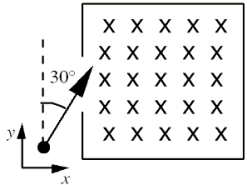
A) up, out of the page
B) at an angle of 30° below the positive x axis
C) at an angle of 30° above the positive x axis
D) at an angle of 60° below the positive x axis
E) at an angle of 60° above the positive x axis
Correct Answer

verified
Correct Answer
verified
Multiple Choice
An electron traveling horizontally enters a region where a uniform magnetic field is directed into the plane of the paper as shown.Which one of the following phrases most accurately describes the motion of the electron once it has entered the field? 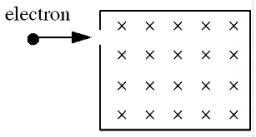
A) upward and parabolic
B) upward and circular
C) downward and circular
D) upward, along a straight line
E) downward and parabolic
Correct Answer

verified
Correct Answer
verified
Multiple Choice
A loop of wire with a weight of 0.55 N is oriented vertically and carries a current I = 2.25 A.A segment of the wire passes through a magnetic field directed into the plane of the page as shown.The net force on the wire is measured using a balance and found to be zero.What is the magnitude of the magnetic field? 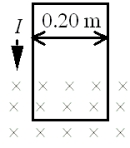
A) zero tesla
B) 0.51 T
C) 0.84 T
D) 1.2 T
E) 4.5 T
Correct Answer

verified
Correct Answer
verified
Multiple Choice
A long, straight wire carries a current I.If the magnetic field at a distance d from the wire has magnitude B, what is the magnitude of the magnetic field at a distance 2d from the wire?
A) B/2
B) B/4
C) 2B
D) 4B
E) 8B
Correct Answer

verified
Correct Answer
verified
Multiple Choice
Two loops carry equal currents I in the same direction.They are held in the positions shown in the figure and project above and below the plane of the paper.The point P lies exactly halfway between them on the line that joins their centers.The centers of the loops and the point P lie in the plane of the paper.Which one of the figures below shows the position of a compass needle if the compass were placed in the plane of the paper at P? 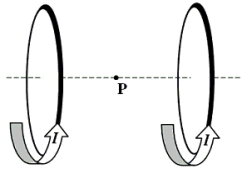
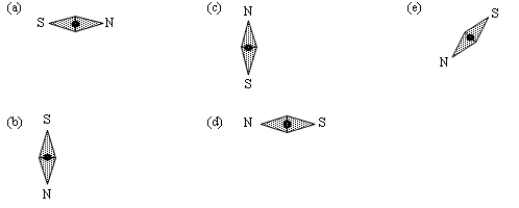
A) a
B) b
C) c
D) d
E) e
Correct Answer

verified
Correct Answer
verified
Multiple Choice
An proton travels through a region of space with no acceleration.Which one of the following statements is the best conclusion?
A) Both E and B must be zero in that region.
B) E must be zero, but B might be non-zero in that region.
C) E and B might both be non-zero, but they must be mutually perpendicular.
D) B must be zero, but E might be non-zero in that region.
E) E and B might both be non-zero, but they must point in opposite directions.
Correct Answer

verified
Correct Answer
verified
Multiple Choice
21-2
A long, straight, vertical segment of wire traverses a magnetic field of magnitude 2.0 T in the direction shown in the diagram.The length of the wire that lies in the magnetic field is 0.060 m.When the switch is closed, a current of 4.0 A flows through the wire from point P to point Q. 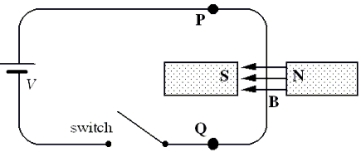 -Which one of the following statements concerning the effect of the magnetic force on the wire is true?
-Which one of the following statements concerning the effect of the magnetic force on the wire is true?
A) The wire will be pushed to the left.
B) The wire will be pushed to the right.
C) The wire will have no net force acting on it.
D) The wire will be pushed downward, into the plane of the paper.
E) The wire will be pushed upward, out of the plane of the paper.
Correct Answer

verified
Correct Answer
verified
Multiple Choice
A coil of wire carries current I as shown in the figure.If the observer could "see" the magnetic field inside this arrangement of loops, how would it appear? 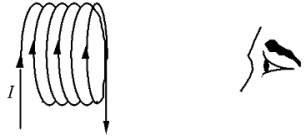

A) a
B) b
C) c
D) d
E) e
Correct Answer

verified
Correct Answer
verified
Multiple Choice
A charged particle is moving in a uniform, constant magnetic field.Which one of the following statements concerning the magnetic force exerted on the particle is false?
A) The magnetic force does no work on the particle.
B) The magnetic force increases the speed of the particle.
C) The magnetic force changes the velocity of the particle.
D) The magnetic force can act only on a particle in motion.
E) The magnetic force does not change the kinetic energy of the particle.
Correct Answer

verified
Correct Answer
verified
Multiple Choice
21-6
Two long, straight wires separated by 0.10 m carry currents of 18 A and 6 A in the same direction as shown.  -Which one of the following materials is not ferromagnetic?
-Which one of the following materials is not ferromagnetic?
A) iron
B) chromium dioxide
C) nickel
D) aluminum
E) cobalt
Correct Answer

verified
Correct Answer
verified
Multiple Choice
21-7
A long, coaxial cable, shown in cross-section in the drawing, is made using two conductors that share a common central axis, labeled C.The conductors are separated by an electrically insulating material that is also used as the outer cover of the cable.The current in the inner conductor is 2.0 A directed into the page and that in the outer conductor is 2.5 A directed out of the page.The distance from point C to point A is 0.0015 m; and the distance from C to B is 0.0030 m.The radii a and b of the conductors are 6.0 × 10-4 m and 1.9 × 10-3 m, respectively. 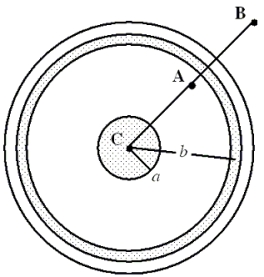 -What is the magnitude and direction of the magnetic field at point B?
-What is the magnitude and direction of the magnetic field at point B?
A) 3.3 × 10-5 T, clockwise
B) 3.3 × 10-5 T, counterclockwise
C) 6.8 × 10-5 T, clockwise
D) 6.8 × 10-5 T, counterclockwise
E) 2.7 × 10-4 T, clockwise
Correct Answer

verified
Correct Answer
verified
Multiple Choice
21-5
Two long, straight, parallel wires separated by a distance d carry currents in opposite directions as shown in the figure.The bottom wire carries a current of 6.0 A.Point C is at the midpoint between the wires and point O is a distance 0.50d below the 6-A wire as suggested in the figure.The total magnetic field at point O is zero tesla. 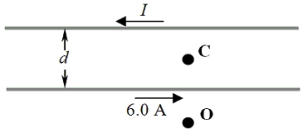 -Determine the magnitude of the magnetic field at point C if d = 0.10 m.
-Determine the magnitude of the magnetic field at point C if d = 0.10 m.
A) 2.4 × 10-5 T
B) 4.8 × 10-5 T
C) 9.6 × 10-5 T
D) 1.1 × 10-4 T
E) 1.4 × 10-4 T
Correct Answer

verified
Correct Answer
verified
Multiple Choice
21-1
A beam consisting of five types of ions labeled A, B, C, D, and E enters a region that contains a uniform magnetic field as shown in the figure below.The field is perpendicular to the plane of the paper, but its precise direction is not given.All ions in the beam travel with the same speed.The table below gives the masses and charges of the ions.Note: 1 mass unit = 1.67 × 10-27 kg and e = 1.6 × 10-19 C  -Which ion falls at position 2?
-Which ion falls at position 2?
A) A
B) B
C) C
D) D
E) E
Correct Answer

verified
Correct Answer
verified
Multiple Choice
An electron traveling due north enters a region that contains a uniform magnetic field that points due east.In which direction will the electron be deflected?
A) east
B) west
C) up
D) down
E) south
Correct Answer

verified
Correct Answer
verified
Multiple Choice
21-2
A long, straight, vertical segment of wire traverses a magnetic field of magnitude 2.0 T in the direction shown in the diagram.The length of the wire that lies in the magnetic field is 0.060 m.When the switch is closed, a current of 4.0 A flows through the wire from point P to point Q.  -A current-carrying, rectangular coil of wire is placed in a magnetic field.The magnitude of the torque on the coil is not dependent upon which one of the following quantities?
-A current-carrying, rectangular coil of wire is placed in a magnetic field.The magnitude of the torque on the coil is not dependent upon which one of the following quantities?
A) the magnitude of the current in the loop
B) the direction of the current in the loop
C) the length of the sides of the loop
D) the area of the loop
E) the orientation of the loop
Correct Answer

verified
Correct Answer
verified
Multiple Choice
Two particles move through a uniform magnetic field that is directed out of the plane of the page.The figure shows the paths taken by the two particles as they move through the field.The particles are not subject to any other forces or fields.Which one of the following statements concerning these particles is true? 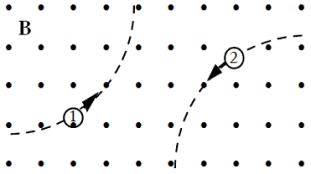
A) The particles may both be neutral.
B) Particle 1 is positively charged; 2 is negative.
C) Particle 1 is positively charged; 2 is positive.
D) Particle 1 is negatively charged; 2 is negative.
E) Particle 1 is negatively charged; 2 is positive.
Correct Answer

verified
Correct Answer
verified
Showing 21 - 40 of 66
Related Exams